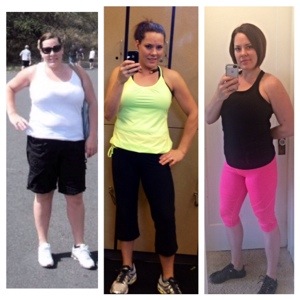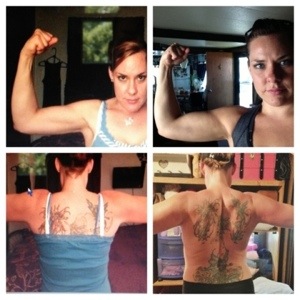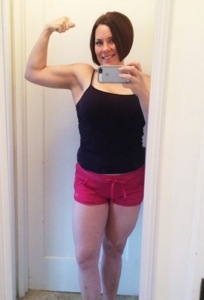
by EM2WL | Jan 17, 2014 | Consistency, Diet Mentality, Fat Loss / Cutting, Motivation, Self Acceptance

A huge key to success is properly framing your goals.
State your goals in a positive manner rather than a negative one. So, instead of listing all the things you’re going to give up (i.e. stop eating processed food), list the things you will gain (i.e. eating more whole foods). Believe it or not, re-framing your goals in the positive can help to remove mental blocks and get you closer to your goal. After all, no one wants to be restricted from doing something.
In our last post in the goal setting series, Trish talked about setting behavior-based versus outcome-based goals. To recap, setting behavior-based goals are specific, measurable actions that you can take to accommodate the results you desire. For example, instead of saying, “I want to lose 5 pounds this month,” you might say, “I will log my food to make sure I nail my macros.”
Today let’s talk about how you frame your goals. It may seem like a silly technicality, but whether we approach our goals in a negative or positive light will make a huge difference in how we approach this journey.
If you begin your journey with a list of things you must not do or must not eat, your fitness life can seem like a very negative and punishing place, full of restrictions. Who wants to live like that? The more that you tell yourself you can’t (or must not, under any circumstances, WHATSOEVER!!!!!!) have something, the more you tend to want it. It is simply human nature to want that which is forbidden.
 Think about it. If you’ve ever dieted, you can probably relate to this scenario. You determine you are going to cut out every bit of added sugar to your diet. What happens the first time you have a little slip-up and allow yourself a piece of candy? Are you able to stop at just one, or are you compelled to finish the whole bag to get that pesky craving “out of your system?”
Think about it. If you’ve ever dieted, you can probably relate to this scenario. You determine you are going to cut out every bit of added sugar to your diet. What happens the first time you have a little slip-up and allow yourself a piece of candy? Are you able to stop at just one, or are you compelled to finish the whole bag to get that pesky craving “out of your system?”
Instead of thinking about the behaviors that you need to stop, or do less of, what behaviors do you need to begin or do more of to accomplish your goals?
Increasing the frequency of healthy, goal-oriented behaviors will automatically crowd out the unhealthy, goal-sabotaging behaviors.
For example, instead of telling yourself that you need to eat less junk food, perhaps you could challenge yourself to try out some healthy alternatives to your family’s favorite fast food meals. Think about challenging yourself to incorporate one new healthy habit each month until they become second nature.
Even if your body is adequately nourished with a proper number of calories, impeccable macros, and sufficiently hydrated, you may feel mentally restricted if you are still telling yourself there are foods you cannot eat. Make sure that you plan to incorporate some of your favorite treats along the way as you progress towards your goals. Unless you have an actual physical intolerance to a certain food, there is no reason why most foods cannot be part of your healthy eating plan, regardless if your goal is to lose fat, gain muscle, or work on body recomposition.
This approach can be applied to your fitness goals as well. Instead of thinking, “I need to tighten up these flabby thighs,” focus on the changes you need to make to see the results you crave. Instead, you might focus on adding 25 pounds to your squat or improving your 5k time.  Focusing on becoming a stronger individual in the gym will most likely lead to positive changes in your body. However, prioritizing strength and athleticism over physical appearance puts the control in your hands, and you will get to experience the empowerment and satisfaction of setting new PRs and watching yourself become stronger each day!
Focusing on becoming a stronger individual in the gym will most likely lead to positive changes in your body. However, prioritizing strength and athleticism over physical appearance puts the control in your hands, and you will get to experience the empowerment and satisfaction of setting new PRs and watching yourself become stronger each day!
Enjoy the road ahead! Be kind to yourself as you work towards your 2014 goals. This journey is challenging enough without adding negativity and self-hate.
Keep your eyes fixed on your goals, and enjoy every moment and the lessons you will learn along the way. Here’s to your best year yet!
Photo credit: jscreationz, ambro, David Costillo Dominci, annankkml of freedigitalimages.net
Becca is a busy wife and homeschooling mother to five children ages 5 to 13. About three years ago, she embarked on a journey to health and fitness that resulted in the loss of approximately 100 pounds. Today, she is a competitive powerlifter and strongwoman who loves ice cream and deadlifts. As an ISSA certified personal trainer, she is passionate about helping women to get started on a lifestyle of strength and fitness.

by EM2WL | Jan 15, 2014 | Fat Loss / Cutting, Testimonials, The Journey
 I am so much stronger, mentally and physically than I ever realised I could be, and so much of that I credit to trusting the process of Eat More To Weigh Less and challenging and trusting myself. I’m the lowest weight I’ve been since my mid 20s (I’m now 31) and my heart is lighter too.
I am so much stronger, mentally and physically than I ever realised I could be, and so much of that I credit to trusting the process of Eat More To Weigh Less and challenging and trusting myself. I’m the lowest weight I’ve been since my mid 20s (I’m now 31) and my heart is lighter too.
I’ve lost over 29kgs / 64.3lbs in the last year. I now buy clothes in “straight sizes” instead of “plus sizes.” I lost most of that weight in the six months since I’ve been following Eat More To Weigh Less. I’m not at my “goal weight” yet but that has become less important over time, especially as I reflect on how I’ve changed my relationship with my body and food over the last year to a healthy one. For me the main reason to care about the number on the scale now is because one of my goals for 2014 is to be able to deadlift my own body weight. I focus on small weight loss goals at a time with no “ultimate” number in mind. I now celebrate muscle and strength gains more than I celebrate a loss on the scale. Eat More To Weigh Less has taught me how much the diet industry and women’s media has failed us, and lied to us. When I reflect on the knowledge I have now and share it with others who ask how they can be successful with weight loss like I am, this process feels like a radical truth.
Ten years ago I was thrown against a wall by an ex and suffered from what was probably undiagnosed whiplash. I spent the next decade in chronic and debilitating pain and experienced frequent migraines. The pain was so bad a neurologist said the reason I spent a year throwing up multiple times a day was “stomach migraine.” I was really fit and slim before the injury but now in pain, I became afraid of movement, my body got fat and tired and my anxiety and depression got worse. I had a couple of years of intensive physiotherapy for my neck, which didn’t help. I lived like a victim. This man wasn’t the last abuser in my life, but he was the one who did the most mental and physical damage.
I worked so hard over the years to heal from this trauma and made some progress, but never got there while overwhelmed with other chronic health issues and battling with my weight. Over the last couple of years I have followed my intuition to release that trauma, making unconventional choices in the right “therapies” or “treatments.” I focused on relationships of love and trust in my life, and learned to love myself past the body positivity I tried to practice. I finally decided that body positivity could also mean it was okay to want to change my body. When I joined MyFitnessPal earlier in 2013, I wanted to lose weight but realised I needed to stop crash dieting, because I would lose only to regain. I’d been doing a lot of cardio and resistance training, but I didn’t feel balanced, and I was still binge eating. Overcoming disordered eating is possible, but it took me months of mindfulness and vigilance, and realising that instant gratification wasn’t helping or satisfying me.
I was lucky that some of the women on my friends list were following Eat More To Weigh Less, and I was encouraged to check out the forum and website. I had been eating my BMR (and not eating back any exercise calories) and losing weight, but with all the exercise I was doing I was hungry all the time. In June I took a leap of faith and upped my calories slowly. Since then I have a better grasp of my TDEE and eat a 10-20% cut which is around 2000 calories a day to lose weight. When I started eating more was when really started to make strength gains and lose more weight, consistently. There were times when I doubted the process, but Eat More To Weigh Less has allowed me more freedom with food and my lifestyle.

I eat sweet treats in moderation (almost daily)
I love food and I’m a great cook, and much of my social life revolves around sharing food with friends. I don’t eat diet foods. I don’t believe food has a moral value and while I enjoy it in moderation, I don’t feel guilty about the choices I make. I don’t punish myself by exercising more just because I ate more on a given day. I’ve always known how to eat healthily (I was brought up vegetarian though I’m no longer one) with a focus on fruit, vegetables and whole grains. My problem was eating too much (sugar especially) with emotional and hormonal binge eating, taking different medications for my health that made me gain even more weight, and not exercising enough. I haven’t cut anything out while counting calories, in fact I’ve probably added more, but with a greater balance. I’ve never liked soft drink and I don’t drink a lot of alcohol either, but still enjoy it on occasion. I could never eat low carb because I love carbs. My main focus is my protein macro and eating over 100g of protein a day, to help in building muscle. I find if I focus on protein all my other macros fall in line. I break so many of those stupid “dieting rules” and eat late dinners, snack late at night (I hate going to bed hungry) and I eat dessert nearly every day. Something so important I learnt when overcoming disordered eating was learning to listen to my body and hunger again, and trust it. I now know when I need to eat more and I’m not afraid to.
This process needs patience and the results will come. Be kind to yourself and nourish your body and mind with good food and new challenges. Celebrate the changes in your body and improvements in fitness and strength. Honour your body for how hard it works for you even with all your perceived imperfections, how you can love and move with it. Reach out to the compassionate, sensible and wise EM2WL team and forum members when you’re struggling or unsure.
I made 2013 my year of focusing on getting other chronic health conditions I had under control. Eating more and being fitter and stronger helped me find the courage and energy to pursue treatments I needed, because I didn’t want anything holding me back with my fitness goals! I grew bored with the cardio and resistance training I was doing. A girlfriend of mine loved lifting and talked about it all the time and I was in awe of her, but still afraid of further injuring my neck and being in more pain. I saw all the inspiring women from Eat More To Weigh Less on my friends list lifting and I wanted to start. Your encouragement made me feel braver. I paid a trainer for a few sessions to teach me how to correctly and safely do compound lifts, and then started StrongLifts on my own.

I include Pilates just for “kicks”
I’m always looking for ways to challenge my fitness rather than staying still physically (and mentally). Kiki recently helped me reflect on how my relationship with cardio has changed. I used to do more cardio so I could burn more and lose more, and that worked because I was eating well. That approach is boring and exhausting though. I even used to do cardio and lift weights on the same days, I’d hate to contemplate doing that often now! My cardio goal for next year is to find more opportunities and time to go on hikes with local groups, because it’s nice to get out of the city and the hikes are challenging. I get a lot of NEAT because I don’t have a car and I walk a lot. I’ve never been a runner but I’ve started doing C25K. I really look forward to it and love that it’s only a half hour commitment three times a week. I LOVE how efficient my workout is when I concentrate on compound lifts three times a week. Something Kiki wrote that resonated with me about designing her workout schedule: “some things are included out of necessity, and other just for kicks.” For me, lifting and doing some cardio is necessary, and Pilates is my kicks when I find time for it, or yoga. I change my workout routine as I accomplish goals or get bored and need variety. I’m never doing hours of cardio again though, unless it’s outdoors. I even want to do Park Runs next year – the old me would have shied from running outdoors with people I don’t know.
When I started lifting heavy weights and got strong it all came together. Today I have a strong back and shoulders and can hold my neck up without exhaustion or pain. My posture has improved. My chronic pain is gone and I rarely get migraines. I’ve never felt as feminine as I do now with curves and muscle (I joke that my body type is now “muscular hourglass”). I thought there’d be a point before now where I’d look at my body and think, “That’s enough muscle.” I now know I’ve got a long way to go until that point, because I love celebrating more muscle! I’ve become a more confident woman in the last year. I wear sleeveless clothes outside the house now, and even wear a bikini to the beach.
I’m centred and I feel so powerful, and that feeling comes from challenging my strength and building muscle. I never thought I’d want my body to lift weights, and I didn’t know how much I’d enjoy it. Mentally I am calm and I feel like no one could (or should) mess with me. Family, friends and strangers remark on how happy, healthy and strong I am and look. I am less defensive and I don’t live in fear every day. If I ever have a daughter I will encourage her to do a martial art or lift weights, because I believe these are powerful practices to create a mental and physical posture to shield from potential abusers, and live with confidence and strength. To live with power. The real “secret” to my success so far has been getting strong!

I make sure to get in enough protein, & the rest falls into place!
Have an EM2WL transformation to share? Willing to let us tag along on your journey? We’d love to see it! Be featured on our Transformation/Journey page by submitting your story to Success@EM2WL.com

by Trish Adams | Jan 13, 2014 | Motivation
Hopefully your journey is off to an amazing start and you’ve laid out your goals for the next 90 days to a year, and have broken them down into smaller goals that you have a high level of confidence you can achieve. If perchance you haven’t laid out your goals, fear not, it’s never too late to get started. If you have started, well it never hurts to have a recap.
“Setting goals is the first step in turning the invisible into the visible.” -Tony Robbins
In our best year yet post we laid out a game plan for goal setting, separating goals into outcome goals, which are broader and not always under our direct control, and behavioral goals, which are under our direct control and will be the steps you take to achieve your outcome goal. Identifying behavioral goals simply requires a little Q&A session with yourself where you identify the tasks required to obtain a result. By the end of this exercise, you should walk away with the steps needed to achieve your outcome goal.
Once you have both your outcome goals and behavioral goals defined, examine them a bit closer. How specific are they? Can you answer what, where, when and why for the goal? Saying that you will exercise 3 times a week is somewhat specific, but can you be even more specific? For example, specify the days of the week and time that you’ll exercise. Maybe even the type and length of the exercise, so you know when you hit the mark. The more specific you can be with your goals the more clarity, direction and focus you will have. Having goals which are vague leaves room for misinterpretation and difficulty measuring success.
 Next up, make sure that your goals are measurable. This one should be pretty obvious why it’s important. After all, if your goals aren’t measurable, how will you know how you’re progressing? Being able to measure progress will also help you determine if any tweaking or adjustments are needed.
Next up, make sure that your goals are measurable. This one should be pretty obvious why it’s important. After all, if your goals aren’t measurable, how will you know how you’re progressing? Being able to measure progress will also help you determine if any tweaking or adjustments are needed.
Consider whether the goals you have set forth are realistic. That is, are they achievable. Many times we set goals based on a best-case scenario where all things go according to plan. We don’t account for the many unexpected events that occur in our lives. Furthermore, if you’re proposing activity that is new to you, make sure you factor in time for you to get acclimated, pace yourself.
Setting a timeline helps keep you on track and ensures the behaviors you set forth are appropriate for the goal. Losing 5% body fat whenever would require a drastically different set of steps than if you were to set a timeline of 3 months. Goals that are left open-ended tend to get put off until it is convenient. Having a deadline will help keep you motivated and on track. See why it’s important? Good.

Lastly, be sure to write your goals down and refer to them often, even daily. This will help you stay focused, committed and will serve as a reminder of what you want to achieve.
While the outcome goal is important, focus your daily efforts on your behavior goals. These are the steps that will achieve your outcome goals. Stay consistent with these steps and you will be on your way to success!
If you haven’t already, join our protein challenge and check in with us on Facebook, Twitter, and Instagram!

by | Jan 10, 2014 | Increasing calories, Interviews/Guest Posts, Metabolism Reset
Tempted by the bombardment of “get thin quick” diets everywhere you turn? Don’t fall for it! Read on as Team EM2WL’s Becca interviews “Diet Recovery” Author, Matt Stone, about dieting: the dangers, warning signs, and healing process for diet damaged metabolisms.
Can you explain how you became interested in metabolic health?

When I first started doing health research I just tried to get my hands on as much information as possible. I kept hearing the name Broda Barnes mentioned repeatedly. After seeing his name in three or four books I finally decided to look into his work more carefully. I read all of his books and became very interested in the metabolism idea, especially considering two very important factors:
1) I was communicating with a lot of very health-conscious hardcore nutrition freaks that were suffering from symptoms of a low metabolic rate, and it seemed obvious that it had something to do with the health practices they were so obsessively engaged in.
2) I had gone through something in my own life that completely shut down my metabolic rate, so I immediately recognized the validity of the idea that metabolic rate plays a role in the proper functionality of virtually every system in our bodies.
That experience was one of semi-starvation, in part inspired by wanting to be “lean and healthy.” Reading extensively about starvation, including picking my way carefully through Ancel Keys’s 1,300-page book *The Biology of Human Starvation*, provided even more confirmation.
I’ve heard you say, “The perfect diet is very unhealthy.” What do you mean by that? How would you define “healthy eating?”
I think the mindset and mentality of perfection is unhealthy, especially as applied to personal health practices. Every other creature on earth relies completely on instinct to keep itself healthy in terms of the amount of sleep, food, water, and exercise it takes in. Instinct is a far better regulator of internal processes than conscious intellect, which humans are now relying on really for the first time in the history of the world. Ignorance really can be bliss when it comes to nutrition, exercise, fluid consumption, and other health practices that people are willing themselves to do—often in complete opposition to instinctual desires. This is a lot more dangerous than people realize.
itself healthy in terms of the amount of sleep, food, water, and exercise it takes in. Instinct is a far better regulator of internal processes than conscious intellect, which humans are now relying on really for the first time in the history of the world. Ignorance really can be bliss when it comes to nutrition, exercise, fluid consumption, and other health practices that people are willing themselves to do—often in complete opposition to instinctual desires. This is a lot more dangerous than people realize.
I can’t really define healthy eating. It is all relative to a person and his or her immediate hour-to-hour needs. Every person and every day requires different things to be considered “optimal.” I couldn’t even tell a person how much water to drink without taking into considering the amount of exercise they have done that day, the air temperature, their metabolic rate, how much salt they ate in their last meal, the water content of their last meal, and more. And that’s just talking about water. Food is much more complex than that.
In your opinion, are there certain markers of metabolic health we should be looking for? How can we make sure we are keeping our metabolism healthy if our goal is weight loss?
Well first of all I don’t know if weight loss should consciously be a “goal.” A goal implies that are forcing your body to do something whether it wants to or not. In my experience, most who lose weight completely shut down their metabolic health in the process because they are too excited about the weight loss to take note of obvious signs of metabolic doom. The most common signs of metabolic rate falling too low, in my experience, are:
1) Reduced body temperature below 98.6 degrees F or about 37 degrees C.
2) Cold hands and feet.
3) Dry skin, especially around the hands and feet.
4) Drop in sex drive or sexual function.
5) Dry hair and maybe even some hair loss.
6) Constipation and other bowel problems related to a decrease in bowel transit speed such as reflux and bloating.
7) Changes in mood—either increased anxiety/aggression or depression or greater volatility between extreme mental states.
8) Insomnia, especially that ominous, consistent 2-4am wake-up and difficulty falling back to sleep. Those who can still sleep a lot don’t feel particularly rested no matter how much they sleep.
9) Frequent urination, or noticing that a small amount of fluid is enough to send you to the bathroom to pee every 15 minutes.
10) Intensified food cravings (although in some a reduced metabolic rate can shut down appetite, so this is not as consistent as some of the others).
If this sounds like you, don’t even think about trying to lose weight in your current state. If your attempts at losing weight have brought some or all of these things on, stop what you’re doing immediately.
What does low body temperature and being cold all the time have to do with metabolic health?
That’s just the body allocating less energy to staying warm. It’s one of the first things the body sacrifices when it is trying to conserve energy (many times because it perceives a food shortage or other stress). A drop in body temperature of 1 degree is enough for the body to save hundreds of calories throughout a 24-hour period. I see temperatures in the low 90’s in some of the people I communicate with frequently. The animal with the lowest metabolic rate in all of the animal kingdom is the sloth, with a resting body temperature as low as 86 degrees F. Do a little research on
the characteristics that define sloth-like behavior and you’ll see some parallels to the changes humans experience when their metabolic rate falls and the body starts to conserve energy.
Could you explain how foods have heating or cooling properties, and what this means for our metabolism?
 Calories, carbohydrates, and salt have the most stimulating effect on the metabolic rate. But it’s all relative to the water content accompanying those calories, carbohydrates, and salt surprisingly. Someone with a low metabolic rate needs to eat calorie-dense foods with a low water content to raise metabolic rate. Someone with a high metabolic rate can do fine eating foods with a high water content, such as fruits, vegetables, juices, soups, salads, and other iconic health foods. Ironically, if your metabolism is low you will probably heal much faster eating “unhealthy” foods than you will eating “healthy” foods.
Calories, carbohydrates, and salt have the most stimulating effect on the metabolic rate. But it’s all relative to the water content accompanying those calories, carbohydrates, and salt surprisingly. Someone with a low metabolic rate needs to eat calorie-dense foods with a low water content to raise metabolic rate. Someone with a high metabolic rate can do fine eating foods with a high water content, such as fruits, vegetables, juices, soups, salads, and other iconic health foods. Ironically, if your metabolism is low you will probably heal much faster eating “unhealthy” foods than you will eating “healthy” foods.
What is “radical refeeding?” Which individuals need to go through this phase? What role does weight gain have in recovery from dieting?
I’m not sure what “radical refeeding” is. It sounds like it probably involves a skateboard, a halfpipe, and a buffet, lol. I usually call it “rest and refeeding,” and it’s really not all that radical. You just want to achieve a consistent surplus of calories and sleep for several weeks to a few months to encourage the body’s cells to ramp up their energy production (i.e. increase metabolism). People who demonstrate a low body temperature and several signs of a reduced metabolic rate such as the ones discussed above usually get the most benefit from it.
It typically does involve some gain in body fat, followed by a gain in lean body mass, followed by complete weight stabilization eating as much as you want with or without exercise. The gain in body fat is the most important, as an increase in body fat increases the hormone leptin, and this sends a signal to the brain that triggers a big rise in metabolic rate and drop in appetite. The process works essentially the same whether a person is fat or thin. If your body temperature is low and you have some signs of a low metabolic rate, starving yourself and exercising more from that point is most likely to make matters worse and actually backfire long-term.
What role does stress play in our nutritional requirements and how do we adapt our dietary needs to stressful circumstances?
 Stress is by far the greatest facilitator of degeneration and death. Stress is ultimately what ushers us towards the big red exit sign in the sky. But stress isn’t just “worry” but something much broader. Stressors come in dozens of forms and all uniformly cause a rise in stress hormones—the glucocorticoids. These hormones are not without benefit, but they put much of the wear and tear on our systems that ultimately break us down and cause illness. The body seems to instinctively know this and compels us to seek out calorie-dense, highly-palatable foods rich in sugar, starch, salt, and fat when we are exposed to high levels of glucocorticoids.
Stress is by far the greatest facilitator of degeneration and death. Stress is ultimately what ushers us towards the big red exit sign in the sky. But stress isn’t just “worry” but something much broader. Stressors come in dozens of forms and all uniformly cause a rise in stress hormones—the glucocorticoids. These hormones are not without benefit, but they put much of the wear and tear on our systems that ultimately break us down and cause illness. The body seems to instinctively know this and compels us to seek out calorie-dense, highly-palatable foods rich in sugar, starch, salt, and fat when we are exposed to high levels of glucocorticoids.
It’s better to engage in anti-stress activities like warm baths, massages, and extra sleep than it is to try to avoid those types of food under stress. In fact, if you feel strong cravings for those foods, it is not without reason and you should obey them. If you feel that eating those foods is unhealthy or does harm to you, avoid the situations and circumstances that strongly compel you to eat them. Sometimes it’s as simple as eating a bigger breakfast or going to bed earlier. But you can tap on your forehead like a lunatic if you want to, haha.
You say, “You have to solve your weight problem to lose weight, not lose weight to solve your weight problem.” Can you clarify what this means in real life?
Well I’ve already written a lot so I’ll give you the short answer to what otherwise could be a short novel. Intentional weight loss means to actively restrict your diet or burn calories through exercise to force a calorie deficit and lose weight. It has a very high failure rate, and many, such as obesity scholars like Paul Campos and Linda Bacon, believe that intentional weight loss can lead to an increased risk of health problems such as heart disease, diabetes, and even the very obesity people are trying to avoid with this approach. I have always found this to be true personally. Any attempts at losing fat always resulted in increased fatness long-term, despite good results initially.
 If you are always preoccupied with your weight, you will likely always be trying to intentionally intervene with some kind of diet or overzealous exercise program. If anything, these habits just strengthen the resolve of your body to hold onto fat and conserve energy via a reduction in metabolic rate. Constant dieting just sends a repeated famine signal to your physiology, and it intelligently responds.
If you are always preoccupied with your weight, you will likely always be trying to intentionally intervene with some kind of diet or overzealous exercise program. If anything, these habits just strengthen the resolve of your body to hold onto fat and conserve energy via a reduction in metabolic rate. Constant dieting just sends a repeated famine signal to your physiology, and it intelligently responds.
The solution is to stop thinking about it so much and go for more of a spontaneous drop in body fat by improving your personal self-care practices. More nutritious food, better sleep, better relationships, more inspiring/fulfilling work and hobbies, and more time outdoors for starters.
Of course, there is a whole psychological component to it as well. Negative self-image is a powerful stressor, and stress prevents fat loss—even encourages fat gain. If you aren’t upset and ashamed of how you look, you’re much more likely to actually lose fat. Thus, it’s important to resolve body image issues BEFORE losing weight.
And trust me, a pound lost with hard work is likely to come back (because of the body’s reaction to that suffering). A pound lost effortlessly and spontaneously is likely to never return. Anything you do to lose weight should be as easy as it can possibly be and still deliver results.
Here, I’ll go ahead and put some quotes around that and my name so everybody reading this can paste that right onto Twitter and Facebook in early January when everyone else is doing their self-deprecating resolution thing…
“Anything you do to lose weight should be as easy as it can possibly be and still deliver results.” ~Matt Stone; www.180degreehealth.com
How can someone learn more about the resources you offer?
My information is very easy to obtain and is free. Go to my website and you can get my free 90-day eCourse on raising metabolic rate, which will tell you everything you need to know to raise your metabolic rate successfully and why it’s so important to do so) and get my books on the subject for free as well. And that’s www.180degreehealth.com.
 “With a high metabolic rate, EVERYTHING works better.”
“With a high metabolic rate, EVERYTHING works better.”
Matt Stone is an independent health researcher, #1 Amazon bestselling author of more than 15 books, and the founder of 180DegreeHealth, a controversial website that has challenged the status quo on health with a combination of cutting-edge science and radical common sense since 2006.

by EM2WL | Jan 8, 2014 | Building Muscle, Self Acceptance, Testimonials, The Journey, Transformations

All my life I was overweight which turned into obesity in my adulthood. To make matters worse, I had a very sedentary lifestyle. I never exercised, never even played sports. It was a bad combination which seemed to culminate in depression and a terrible body image. In June 2011, I decided to take control.
Over the past 2.5 years, I have tried many different paths to weight loss and fitness. It was fun at times, and other times it was miserable. What it came down to is everything I did, everything I ate seemed to have to point to weight loss or a better body which left me in a constant state of stress and being unsatisfied with myself. With time, patience and a big case of the need-to-know’s, I feel like I have finally arrived at a comfortable, happy, strong place in my life.
I’ve spent the past year focusing on lifting after an injury sidelined me from marathon training.  I was devastated, but I did like lifting, so I thought it would be a good transitional fitness plan. Little did I know that while I was healing, I was catching a fever for strength! I thought I loved running… but the way I felt about running can’t even compare to the way I feel about lifting. I gave up endurance running and my dabblings in strength training, and decided to make lifting “my thing.” I had to get over my fears of giving up the cardio, I also had to get over my fears of TRULY eating to maintenance, and in the process, I quit taking “progress pics” every few weeks. I started looking WITHIN and making changes to match my inner desires and quit looking at it as a means to an end goal of aesthetics.
I was devastated, but I did like lifting, so I thought it would be a good transitional fitness plan. Little did I know that while I was healing, I was catching a fever for strength! I thought I loved running… but the way I felt about running can’t even compare to the way I feel about lifting. I gave up endurance running and my dabblings in strength training, and decided to make lifting “my thing.” I had to get over my fears of giving up the cardio, I also had to get over my fears of TRULY eating to maintenance, and in the process, I quit taking “progress pics” every few weeks. I started looking WITHIN and making changes to match my inner desires and quit looking at it as a means to an end goal of aesthetics.
Suffice it to say, this brings us to today. Well, maybe not literally today, but you know what I mean ;) On Saturday November 30th, I competed in my very first powerlifting meet. It was one of the most rewarding and amazing experiences in my fitness journey to date! I went home with the first place gold medal for my weight class and the biggest grin you can imagine. I am so excited for my future in this sport.
 One thing that I never imagined would happen is that my husband is supremely proud of me and takes every chance he can to brag on me. This is a man who does NOT lift, but is very fit and obviously secure in himself! He loves that I am strong, capable and most of all doing what I love to do. He is constantly telling me how sexy I am, and how lucky he is to have me… and after 11 years of marriage, this is pretty precious. I believe it’s the confidence I now have. Doing what I love doing and being confident must make me more beautiful to him.
One thing that I never imagined would happen is that my husband is supremely proud of me and takes every chance he can to brag on me. This is a man who does NOT lift, but is very fit and obviously secure in himself! He loves that I am strong, capable and most of all doing what I love to do. He is constantly telling me how sexy I am, and how lucky he is to have me… and after 11 years of marriage, this is pretty precious. I believe it’s the confidence I now have. Doing what I love doing and being confident must make me more beautiful to him.
In total, I have lost 75 pounds since June 2011. I have gained about 5-10 back over the past year in lean mass and muscle. My body fat has dropped about 5% since summer of 2012 and most importantly, I have been able to go from eating 1400-1700 cals and “maintaining” the summer of 2012, to eating 2600-3000 and maintaining today.
Success looks different for different people. This is my success. I will not be “more successful” once I lose more fat, or have more developed muscles, I am not just a work in progress. My biggest success lies within and cannot be seen with your eyes, but can be found in my passion, confidence and dedication.

Down 70lbs and maintaining on 2600-3000 cals!

First Powerlifting meet

First place gold medal!
Have an EM2WL transformation to share? Willing to let us tag along on your journey? We’d love to see it! Be featured on our Transformation/Journey page by submitting your story to Success@EM2WL.com

 Think about it. If you’ve ever dieted, you can probably relate to this scenario. You determine you are going to cut out every bit of added sugar to your diet. What happens the first time you have a little slip-up and allow yourself a piece of candy? Are you able to stop at just one, or are you compelled to finish the whole bag to get that pesky craving “out of your system?”
Think about it. If you’ve ever dieted, you can probably relate to this scenario. You determine you are going to cut out every bit of added sugar to your diet. What happens the first time you have a little slip-up and allow yourself a piece of candy? Are you able to stop at just one, or are you compelled to finish the whole bag to get that pesky craving “out of your system?” Focusing on becoming a stronger individual in the gym will most likely lead to positive changes in your body. However, prioritizing strength and athleticism over physical appearance puts the control in your hands, and you will get to experience the empowerment and satisfaction of setting new PRs and watching yourself become stronger each day!
Focusing on becoming a stronger individual in the gym will most likely lead to positive changes in your body. However, prioritizing strength and athleticism over physical appearance puts the control in your hands, and you will get to experience the empowerment and satisfaction of setting new PRs and watching yourself become stronger each day!






















Recent Comments